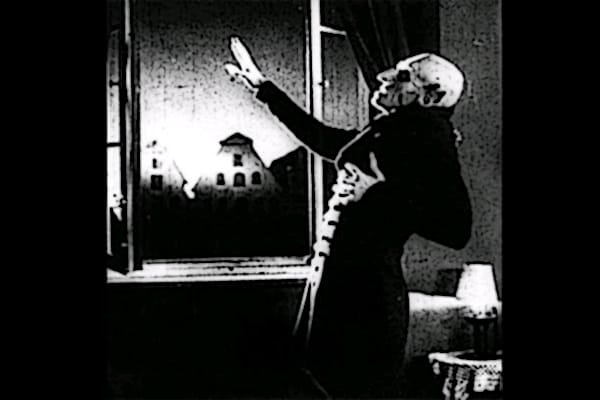Vampire Count Orlok expresses interest in a new residence and real estate agent Hutter's wife. Silent classic based on the story "Dracula."
Max Schreck: Graf Orlok
Made in 1922, Nosferatu is the first big screen adaptation of Bram Stoker’s Dracula, and it is by far the best.
A free adaptation of the famous book, in the hands of director F.W. Murnau the film becomes a multi-dimensional and personal work that diverts from the original. This appropriation by Murnau explains why the title of the film is Nosferatu and not Dracula: Stoker’s widow saw the plagiarism of her husband’s work and brought court action against the production. Though she obtained the destruction of the film negatives, luckily some copies survived this destructive tempest.

Moreover, a beneficial name change preserved the reputation of Murnau’s vampire. While Dracula, the object of many mostly mediocre adaptations, sounds like a grotesque and overused cliche, Nosferatu still resonates with a certain terror. The film has guarded a certain troubling aura, and its only true remake, Werner Herzog’s Nosferatu the Vampyre, is a majestic tribute to its master. The possessed interpretations of Count Orlok by Max Shreck and later Klaus Kinski only reinforce the myth.
However, what many people ignore is the potency of the political message of the film. 1922 was at the height of hyperinflation in the Weimar Republic which ruled over Germany from 1919 to 1933. The public were used to frequent, violent political confrontation between factions on the extreme left and extreme right.
What we see in Nosferatu is a theme typical of early Weimar cinema: the omnipresent, omni-potent tyrant in the form of Nosferatu (also Caligari, Dr. Mabuse etc.). The tyrant comes from the east (it is unsure what this represents, though I would argue that, given the political situation and the recent communist uprising in Russia, it is the Bolshevists) and we see by comparing the first shot of a quiet, tranquil traditional German town and the last shot of a dilapidated, ruined castle, the progress from the bourgeois ideal into anarchy, chaos and destruction during the film.
''It will cost you sweat and tears, and perhaps... a little blood.''
The film shows that no-one was able to stop Nosferatu in his tracks before he arrived to ruin Wisborg, the town where the film is set. Only Ellen, by sacrificing herself and giving her life, can stop the tyrant. So soon after WWI, it is clear that such a sacrifice is not portrayed as desirable. The film removes Van Helsing, the policeman in the Dracula novel, from the plot, meaning that there is no strong force in traditional Germany; The power is held by Hutter, a middle-class estate agent. The middle classes in power at the time in Germany were the liberals of the Weimar Republic. Hutter is portrayed as weak, easily overcome and without much of a clue as to what's going on. This is clearly a call for a strong leader to fill the evident void in Germany, to come in and rescue society from the threat of being taken over by Bolshevism.
When we look at Murnau's later films, such as Dr. Mabuse, Der Spieler, it becomes clear that the right-wing (not Nazi) anti-authoritarian message of the film was not limited to this piece.
Nosferatu marks the transition between Romanticism and Expressionism. The affiliation of Murnau's work to the Romantic movement is evident. Themes like ambivalence (subjectivity and the unconscious, mystery and imagination) as well as the idea of a double, the ambiguous, Gothic, and the communion between the artist and nature are omnipresent in the film. The ambivalence principally affects the characters, from Orlok (count/vampire) to Knock (prominent/crazy) and Hutter (heterosexual husband/homosexual lover) as well as the parallel between the vampire and human worlds (in particular the use of the negative while the coach passes from the normal world to Orlok's). The unconscious, characterized by the Count's constant fear, materializes in nature when he is not onscreen.
For the Romantics, portraits, reflections, and shadows blend into a single entity. The shadow, particularly important (as in the scene as he climbs the stairs), anticipates an imminent danger, embodies a sexual desire, and always betrays the killer in German cinema. Gothic qualities are manifested in the physical characteristics of the vampire and in the architecture. Noseferatu’s bald oval head reflects the Gothic archways of his château, while his twisted body responds to the curves of the gate. His long nails symbolize the East’s despotism and correspond to the elongated lines of Gothic architecture. Finally, nature has a preponderant role, as important as a character. The stretches of land are the mental projections of the characters while the waves of the sea announce the imminent arrival of the count. The mountains have a supernatural side.
A visionary cinematic masterpiece, Nosferatu, is all the more topical as it shows the unequalled potential regarding cinema reduced to its most purified form and, by the same token, is the cruel report initiating the self-exhaustion that lies with modern cinema. If the end of the 90s marked the climax of commercial cinematic exploitation, the 21st century seems to be beginning with a uniquely purposeful horizon. Thus Nosferatu is definitely a timeless masterpiece which any film-maker or lover of film must see, the film which inspired many films and stories to follow.
''Is this your wife? What a lovely throat.''
 Login
Login Posted : 14 years, 11 months ago on 7 June 2010 12:38
Posted : 14 years, 11 months ago on 7 June 2010 12:38
 0 comments,
0 comments,  Posted : 16 years, 11 months ago on 14 June 2008 08:45
Posted : 16 years, 11 months ago on 14 June 2008 08:45